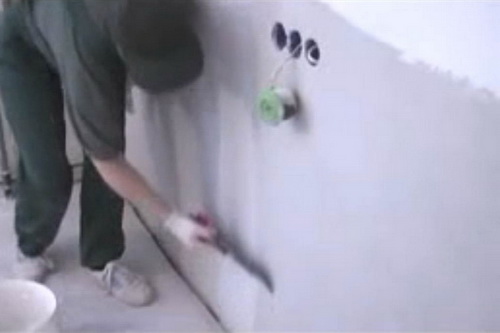
Levkas to plaster and you can, and you need, if you really need to achieve a smooth surface. For many types of finishes, this condition is necessary to obtain a good result.
“Naked” plaster can give the surface some defects such as height differences or cracks, it has great adhesion and is “sharp” for thin wallpapers. Therefore, it is necessary to apply levkas to level the surface, remove differences, smooth out irregularities. Then the paint or "Venetian" will fall perfectly, and the wallpaper will not warp, will not allow the seams to diverge and will not look "pimply".
“Levkas is a kind of putty; recipes in different sources are different. The composition, as a rule, includes chalk, gypsum or alabaster, which are diluted on a water-adhesive basis. In addition, the composition may vary depending on the initial state of the surface to be treated. For embossed surfaces, a semi-liquid solution is taken, for the walls and ceilings a mixture of the type of putty is made. »
An example would be the following composition: gypsum, chalk and diluted wood glue (20-60 g of glue per liter of water) in proportions of 2: 1: 2. Also given is a recipe for liquid levkas: detail 200 g of tiled carpentry glue, pour 1 l of water for 6-8 hours, melt in a water bath after swelling and add sifted chalk into the resulting mass, stirring constantly until sour cream is obtained. Such levkas are applied with a brush, with which, when properly prepared, it drains with long threads.
“Levkasit - to produce high-quality finishing works that allow you to get a very smooth surface. Levkas are used for priming for gilding, painting, thin wallpaper, allowing you to remove all the roughness that will be visible under a similar finish. »
Levkass should be on completely dry plaster. Poorly dried plaster can give yellow spots later on, deform or crack, and then it will be very difficult to eliminate such effects. If you have to work on the old plaster, then you should remove the areas that do not hold well, walk with a spatula along the edge of the cracks, removing all unreliable. If the base is porous, then in addition it does not hurt to go through a special primer and dry it. Only after that you can fix defects with the levkas.
It is recommended to putty a layer not exceeding 2 mm. If necessary, the procedure can be repeated, but well dried the previous layer. More often this term was used for iconography, where chalk (plaster, alabaster) was taken to glue on animal or fish oil with linseed oil, which made it possible to qualitatively prime the prepared board. In the construction used a slightly different composition, and suitable for work not only on wood.
